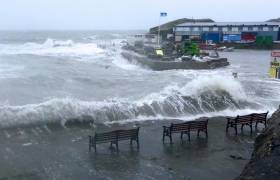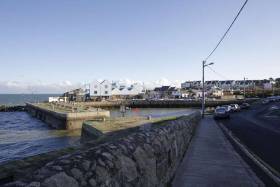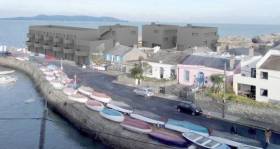Displaying items by tag: Bulloch Harbour
Santa SCUBA Dive for RNLI Returns at Bulloch Harbour This Sunday
This Sunday 11 December, SCUBA divers dressed in Santa suits will once again dive into the sea water at Bulloch Harbour in Dalkey to raise money for the RNLI, the charity that saves lives at sea.
The annual diving event has raised over €20,000 to date since it was started in 2014 by Karen Kenny of Dublin University Sub Aqua Club.
This year divers will assemble at the harbour at 10am with the first subaquatic Santas entering the water at 11am. Dun Laoghaire RNLI’s D-class lifeboat will also be on site, subject to weather and operations, to support the festive dip.
But anyone can take part wherever they may be, the organisers urge, calling on supporters to jump into the sea, a lake, a river or even your bath, all to raise funds for the RNLI.
All you need to do is wear a Santa hat, Santa suit or even just a Christmas bow and make a donation, no matter how small.
Dun Laoghaire Senator Sees Opportunity to Repair Bulloch & Coliemore Harbours Under New Grant Scheme
A Dun Laoghaire Senator has described this week's €35m Brexit Infrastructure Fund as an 'opportunity' for improvement of crumbling Dublin Bay Harbours.
Senator Barry Ward tweeted that both Coliemore and Bulloch Harbours in Dalkey County Dublin and Dun Laoghaire Harbour were all in need of 'urgent attention' in different ways.
Marine Minister Charlie McConalogue T.D., announced on Monday the new scheme to rejuvenate local authority public piers and harbours throughout coastal communities.
An opportunity for @dlrcc to address some of the infrastructural problems in #DúnLaoghaireHarbour, #Colliemore Harbour and #Bulloch Harbour? All in need of urgent attention in different ways.@Bullochharbour @DalkeyF @DalkeyRowing @DLMarina_Dublin @RowDunLaoghaire #Dalkey https://t.co/23IgpGngBB
— Barry Ward (@barrymward) January 25, 2022
Afloat previously reported in 2020 how the popular Dalkey Island seasonal ferryboat stopped service due to a partial collapse of a cliff-face underneath a footpath leading to the pier at Coliemore Harbour, Co. Dublin.
And in 2018, Bulloch Harbour's Bicencentary was against a backdrop of Storm Damage suffered in Storm Emma.
 Senator Barry Ward
Senator Barry Ward
Announcing the scheme, the Minister said this week “This record funding for our coastal communities is an unprecedented opportunity for us to invest in our publicly owned piers and harbours and will shape the future of our coastal communities. Brexit has and will continue to affect our seafood sector in a unique way compared to other industries. I am delighted to be able to offer this level of investment so that we can deliver safe, accessible, lasting infrastructure and support economic diversification right around our coastline.”
Bulloch Harbour: High Court to Hear Campaigners Application Against Housing Proposal
A hearing will be held in the High Court writes Dublin Gazette, on an application by local campaigners against a housing development at Bulloch Harbour, Dalkey next week.
Earlier this year, the controversial development got the green light from An Bord Pleanala for three three-storey houses, two apartments, a cafe and a number of other buildings.
There has been anger among some locals, who feel the proposals don’t fit in with the landscape of the surrounding area, and there are also concerns about the potential for flooding.
Save Bulloch Harbour is a campaign led by Bulloch Harbour Preservation Association (BHPA), made up of local boat owners, fishermen, harbour users and residents.
Next Monday, October 14, the high court will hear BHPA’s application for a judicial review of An Bord Planala’s decision to grant planning permission for the proposed development.
For more read here including details of a public meeting to be held by BHPA.
Dublin Gazette writes, that the Bulloch Harbour Preservation Association has announced it has begun fundraising to file for a judicial review of An Bord Pleanala’s (ABP) decision to grant planning permission for a property development on Bulloch Harbour.
Earlier this month ABP granted permission to Bartra Capital Property Group to build three, three storey villas, two apartments as well as number of other buildings such as a café on the iconic south Dublin harbour.
At the time of the decision, Bartra CEO Mike Flannery said this “marks a positive day for Bulloch Harbour and Bartra looks forward to enhancing the environs of Bulloch Harbour on the back of this decision.”
However, local residents who have opposed the development since Bartra originally submitted its proposals have announced they will be attempting to file for a judicial review of the granted planning permission.
In a statement, the association said: “We have been inundated with communications by the members of the public expressing their amazement, disbelief and outrage at the findings of ABP.
For more on this coastal development click here.
As previously reported on Afloat.ie works to repair Bulloch Harbour in Dalkey along south Dublin Bay is focused on a pier damaged by Storm Emma in March of last year, writes Jehan Ashmore.
According to Bullock Harbour Preservation Association the repairs to the pier's outer north-eastern corner which is exposed to the bay is almost complete. The pier leads off from a quay where a controversial mixed development was recently given the go ahead by An Bord Pleanála at the site of the former Western Marine premises.
The Association which liaises with public bodies and other interested parties to ensure the harbour functions and remains a public asset also provided an update concerning the pier's inner south-western corner.
At this section of the pier which had been subsiding since last summer has now been totally dismantled down to the harbour bottom. It is at this level where new concrete foundations have been laid underwater so that the granite blocks can be reset in their original positions. A completion date for this work is not yet known.
The scenic stone-cut harbour built in 1818/19 by the Ballast Board (now Dublin Port Company) still manages the small working harbour which celebrated its Bicentenary last winter. The small harbour is home to inshore fishing boats engaged in crab and lobster, boat moorings, boat rental operations, the Dalkey Sea Scouts, kayakers, sea anglers and for other marine leisure pursuits.
Access for such activity requires roads in the vicinity of Bulloch Harbour which is the responsiblity of Dun Laoghaire Rathdown County Council. The local authority is currently inviting the public and interested parties to submit obervations and submissions to the Bulloch and Sandycove Harbours Draft Masterplan as previously included. The neighbouring harbour at Sandycove is located further along the coast to the north in Scotsman's Bay.
For further details on the Masterplan click here noting the closing date for submissions is Monday, 19th August.
Development at Bulloch Harbour in Dalkey Gets Go-Ahead
The Irish Times writes of a controversial development proposal for a scenic south Dublin fishing harbour has been given the go ahead by An Bord Pleanála.
Bartra Property, after a protracted planning struggle, has received permission to build a number of housing units at Bulloch Harbour in Dalkey.
It will consist of three three-storey houses, two apartments and a cafe as well as a number of other buildings.
Residents living at and near the picturesque coastal inlet, popular with tourists and for fishing, have long battled the proposals they believe are out of kilter with the surrounding area. Concerns have also been repeatedly aired as to the potential for flooding due to often high sea levels.
Local People Before Profit TD Richard Boyd Barrett said the decision was “incomprehensible”.
“Bulloch Harbour is a unique public amenity used by people of all ages. It is an important part of the heritage of south County Dublin, ” he said.
For more on this coastal development click here.
Bullock 200th Lecture: "The Port Across the Bay - Evolution from the Early 19th Century to 2040"
#lectures - As part of the Bullock Harbour Bicentenary celebrations, the next lecture is to be held on Tuesday (12 March) in the Dalkey Castle and Heritage Centre.
The free lecture programme which began last year has been organised by the Bullock Harbour Preservation Association (BHPA) in conjunction with the Dublin Port Company. So far the lecture themes have concentrated on the history and heritage of Bullock, an attractive small stone cut harbour located near Dalkey town.
As for the next lecture this will take focus onto the horizon!... as the talk's title is "The Port across the Bay - evolution from the early 19th century to 2040". The lecture is to be presented by Eamonn O'Reilly, Chief Executive Officer of the Dublin Port Company.
All are welcome to the lecture which will take place at 8pm in the Dalkey Castle & Heritage Centre.
Please be advised that there is now no need to book places as admission is free and the venue is large enough to accommodate all-comers.
Bullock 200th Lectures in Dalkey Resumes With Talk On “The Building of Bullock Harbour”
#lectures - As part of the Bullock 200 Bicentenary, as previously reported on Afloat.ie, the Bullock Harbour Preservation Association and Dublin Port Company resume a series of talks held in the Dalkey Castle and Heritage Centre.
Next week, on Tuesday, 22nd January at 8pm, a talk titled “The Building of Bullock Harbour” will be given by Elizabeth Shotton, Associate Professor at the UCD School of Architecture, Planning & Environmental Policy. Admission is free though places should be booked in advance with the Heritage Centre by emailing: [email protected]
Construction of Bulloch Harbour began in the winter of 1818/1819 by the Ballast Board (now Dublin Port Company) and in relationship to up-keep and maintenance of Bulloch Harbour involves the DPC in initiatives in conjunction with the BHPA and Dalkey Tidy Towns, see related storm damage story.
Returning to the lectures which began late last year (see below), they will continue up to May 2019 and will focus on the history and heritage of Bullock presented by excellent speakers from the Port Company and elsewhere. The lectures programme as usual will take place at 8pm in the heritage centre.
The first two lectures by Lar Joye, Port Heritage Director, and Rob Goodbody, local historian, were very well received by large audiences in the heritage centre located in Goat's Castle. The castle in Dalkey, is one of only two surviving seven fortified town houses/castles built to store cargo which were off-loaded in Dalkey during the Middle Ages, when Dalkey acted as the port for Dublin between mid-1300s to the late 1500s.
During those times, large Anglo-Norman ships could not access Dublin, as the river Liffey was silted up and navigating was notoriously difficult and dangerous leading to numerous shipwrecks. Instead vessels anchored safely in the deep waters of Dalkey Sound. When the issue of silting on the Liffey was eventually resolved, larger ships could enter Dublin which began with the expansion of the port from the late 1700's.
The Bulloch Harbour lectures have also been supported by the Dalkey Community Council, Dalkey Tidy Towns and the Dalkey Castle & Heritage Centre.
Controversial Bulloch Harbour Development Refused Planning Permission
#BullochHarbour - A controversial development proposed at Bulloch Harbour, an inlet close to Dalkey in the south Dublin has been refused planning permission.
As The Irish Times writes, Bartra Capital Ltd, founded by developer Richard Barrett, had filed plans last December for seven ground-floor commercial units and six three-storey terraced dwellings at the end of the harbour, as well as a further three houses to the rear of the development.
The plan prompted an immediate reaction from the local community, with a number of public meetings held on the proposals.
Almost 300 formal objections to the development were filed with Dún Laoghaire-Rathdown County Council.
Planners have now decided to deny permission for the project, saying in a statement that they considered the amount of site area which is reserved for residential use to be excessive.
“Together with the design and layout of the development and the inadequate provision for marine-related uses, [it] seriously compromises the achievement of a quality mixed-use and integrated development, with adequate and appropriate provision for marine and harbour-related activities,” the planners said.
‘Utterly inappropriate’
Local People Before Profit councillor Melisa Halpin welcomed the decision, saying the plans were “utterly inappropriate” for the harbour.
Ms Halpin said it was now time to push for a strategic plan for the harbour which would safeguard it against future, similar proposals.
Residents To Fight ‘Costa del Sol’ Style Development in Dalkey
#BullochHarbour - A major campaign in Dalkey is under way to stop what has been described as the ‘Costa del Sol’ style development at Bulloch Harbour in south Dublin.
As The Irish Times writes on the eve of its 200th anniversary, the coastal inlet has been selected by developers as previously reported on Afloat for a commercial and residential scheme that would visually transform a postcard quay popular with fishermen and tourists.
The controversial plans have drawn the ire of local residents, more than 300 of whom crammed into a public meeting at the Fitzpatrick Castle Hotel in Killiney on Thursday to discuss mass opposition.
A 50-minute presentation described a harbour that has existed for hundreds of years and whose modern walls were constructed over just eight months in 1818.
In December, Bartra Capital Ltd, founded by developer Richard Barrett, filed a planning application that would see the replacement of a number of disused sheds with seven ground floor commercial units and six three-storey terraced dwellings,plus a further three houses to the rear.
“This development could be taken from the Costa del Sol. It’s not Irish seaside architecture,” said Susan McDonnell, chair of the Bulloch Harbour Preservation Association (BHPA), outlining the contentious plans.
Those in attendance groaned at a crude computer mock-up depicting dark buildings towering over the existing colourful harbour scene.
For more including slide images of a before and after of the projected development (3-D graphic above) at Dalkey click here.


































































